Meeting Service User Needs: A Detailed Care Plan for Ola Adeyemi
VerifiedAdded on 2023/06/17
|15
|4368
|464
Report
AI Summary
This report outlines the development of a person-centered care plan for Ola Adeyemi, a 30-year-old individual with Down syndrome, aiming to enhance his independence and quality of life. The assessment, based on the APIE (Assessment, Planning, Implementation, Evaluation) model, identifies Ola's strengths, goals, and specific needs, including financial support, accommodation, and improvement in speech and motor skills. The care plan incorporates interventions such as social and emotional support, assistive technology, special education, physical therapy, and speech therapy. It addresses both individual and social aspects of disability, emphasizing Ola's active participation in his care. The ultimate goals are to foster self-care awareness, improve physical and learning abilities, and facilitate independent living and employment. The report also reflects on the role of the social care worker in coordinating these interventions and providing holistic support.
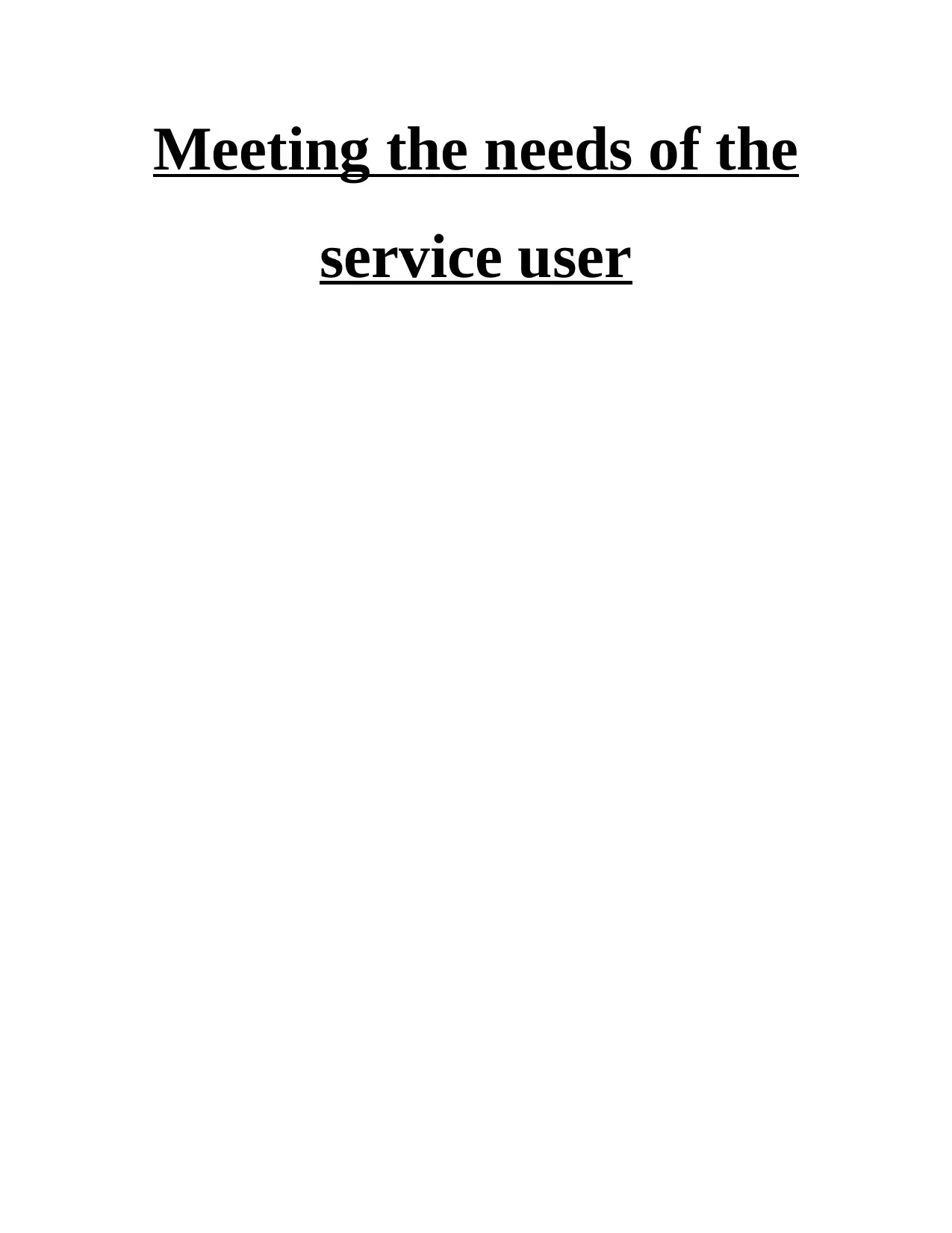
Meeting the needs of the
service user
service user
Paraphrase This Document
Need a fresh take? Get an instant paraphrase of this document with our AI Paraphraser
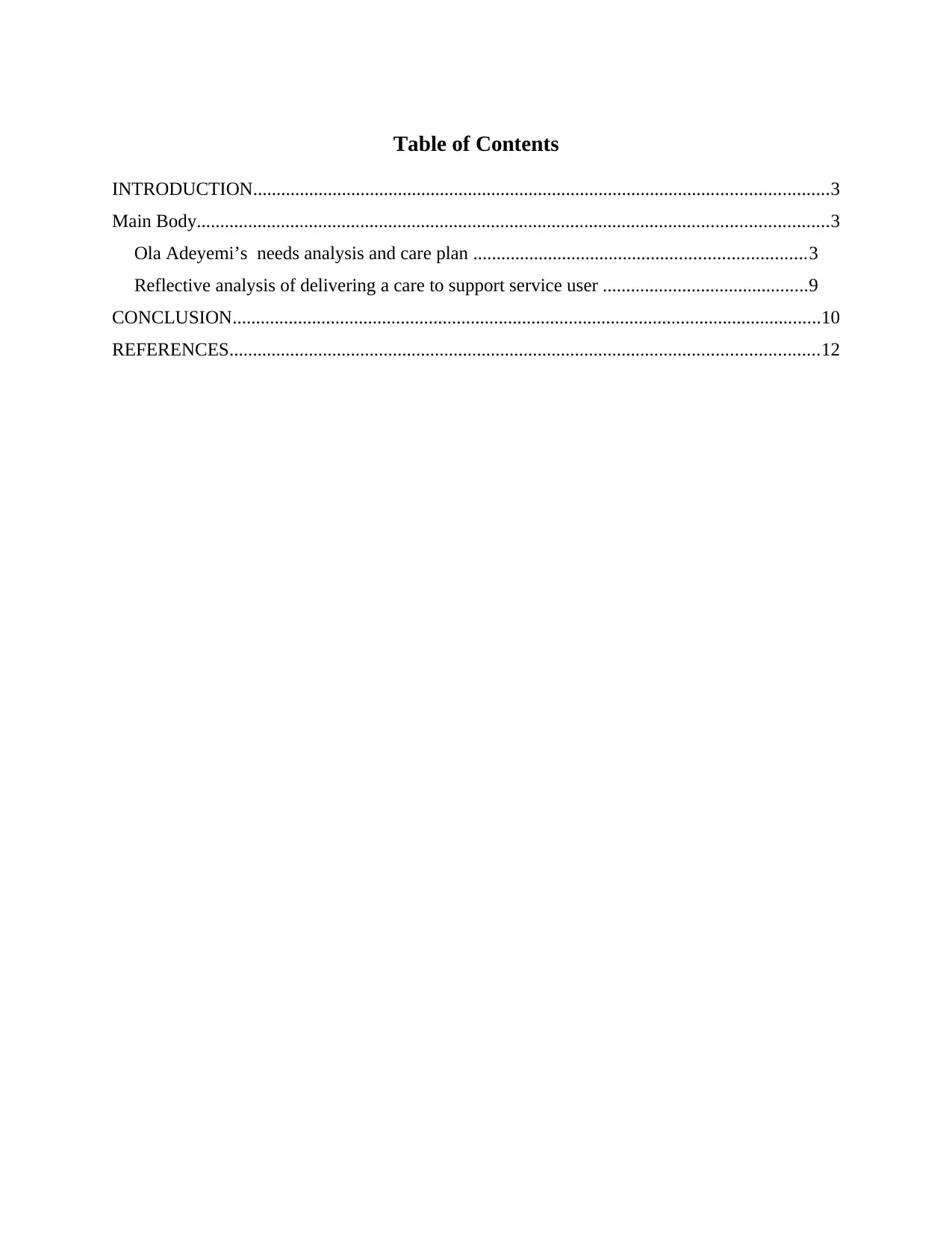
Table of Contents
INTRODUCTION...........................................................................................................................3
Main Body.......................................................................................................................................3
Ola Adeyemi’s needs analysis and care plan .......................................................................3
Reflective analysis of delivering a care to support service user ............................................9
CONCLUSION..............................................................................................................................10
REFERENCES..............................................................................................................................12
INTRODUCTION...........................................................................................................................3
Main Body.......................................................................................................................................3
Ola Adeyemi’s needs analysis and care plan .......................................................................3
Reflective analysis of delivering a care to support service user ............................................9
CONCLUSION..............................................................................................................................10
REFERENCES..............................................................................................................................12
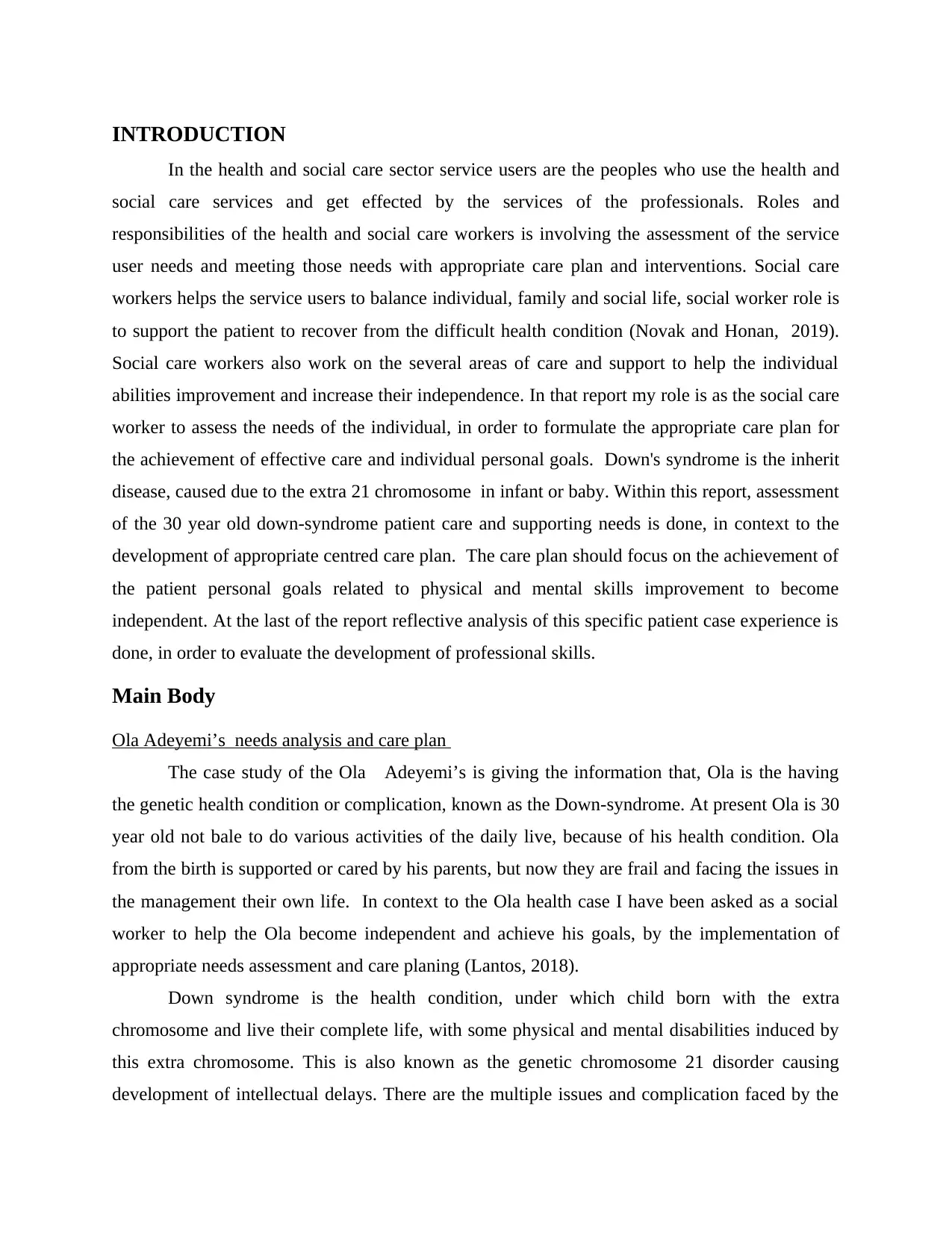
INTRODUCTION
In the health and social care sector service users are the peoples who use the health and
social care services and get effected by the services of the professionals. Roles and
responsibilities of the health and social care workers is involving the assessment of the service
user needs and meeting those needs with appropriate care plan and interventions. Social care
workers helps the service users to balance individual, family and social life, social worker role is
to support the patient to recover from the difficult health condition (Novak and Honan, 2019).
Social care workers also work on the several areas of care and support to help the individual
abilities improvement and increase their independence. In that report my role is as the social care
worker to assess the needs of the individual, in order to formulate the appropriate care plan for
the achievement of effective care and individual personal goals. Down's syndrome is the inherit
disease, caused due to the extra 21 chromosome in infant or baby. Within this report, assessment
of the 30 year old down-syndrome patient care and supporting needs is done, in context to the
development of appropriate centred care plan. The care plan should focus on the achievement of
the patient personal goals related to physical and mental skills improvement to become
independent. At the last of the report reflective analysis of this specific patient case experience is
done, in order to evaluate the development of professional skills.
Main Body
Ola Adeyemi’s needs analysis and care plan
The case study of the Ola Adeyemi’s is giving the information that, Ola is the having
the genetic health condition or complication, known as the Down-syndrome. At present Ola is 30
year old not bale to do various activities of the daily live, because of his health condition. Ola
from the birth is supported or cared by his parents, but now they are frail and facing the issues in
the management their own life. In context to the Ola health case I have been asked as a social
worker to help the Ola become independent and achieve his goals, by the implementation of
appropriate needs assessment and care planing (Lantos, 2018).
Down syndrome is the health condition, under which child born with the extra
chromosome and live their complete life, with some physical and mental disabilities induced by
this extra chromosome. This is also known as the genetic chromosome 21 disorder causing
development of intellectual delays. There are the multiple issues and complication faced by the
In the health and social care sector service users are the peoples who use the health and
social care services and get effected by the services of the professionals. Roles and
responsibilities of the health and social care workers is involving the assessment of the service
user needs and meeting those needs with appropriate care plan and interventions. Social care
workers helps the service users to balance individual, family and social life, social worker role is
to support the patient to recover from the difficult health condition (Novak and Honan, 2019).
Social care workers also work on the several areas of care and support to help the individual
abilities improvement and increase their independence. In that report my role is as the social care
worker to assess the needs of the individual, in order to formulate the appropriate care plan for
the achievement of effective care and individual personal goals. Down's syndrome is the inherit
disease, caused due to the extra 21 chromosome in infant or baby. Within this report, assessment
of the 30 year old down-syndrome patient care and supporting needs is done, in context to the
development of appropriate centred care plan. The care plan should focus on the achievement of
the patient personal goals related to physical and mental skills improvement to become
independent. At the last of the report reflective analysis of this specific patient case experience is
done, in order to evaluate the development of professional skills.
Main Body
Ola Adeyemi’s needs analysis and care plan
The case study of the Ola Adeyemi’s is giving the information that, Ola is the having
the genetic health condition or complication, known as the Down-syndrome. At present Ola is 30
year old not bale to do various activities of the daily live, because of his health condition. Ola
from the birth is supported or cared by his parents, but now they are frail and facing the issues in
the management their own life. In context to the Ola health case I have been asked as a social
worker to help the Ola become independent and achieve his goals, by the implementation of
appropriate needs assessment and care planing (Lantos, 2018).
Down syndrome is the health condition, under which child born with the extra
chromosome and live their complete life, with some physical and mental disabilities induced by
this extra chromosome. This is also known as the genetic chromosome 21 disorder causing
development of intellectual delays. There are the multiple issues and complication faced by the
⊘ This is a preview!⊘
Do you want full access?
Subscribe today to unlock all pages.

Trusted by 1+ million students worldwide
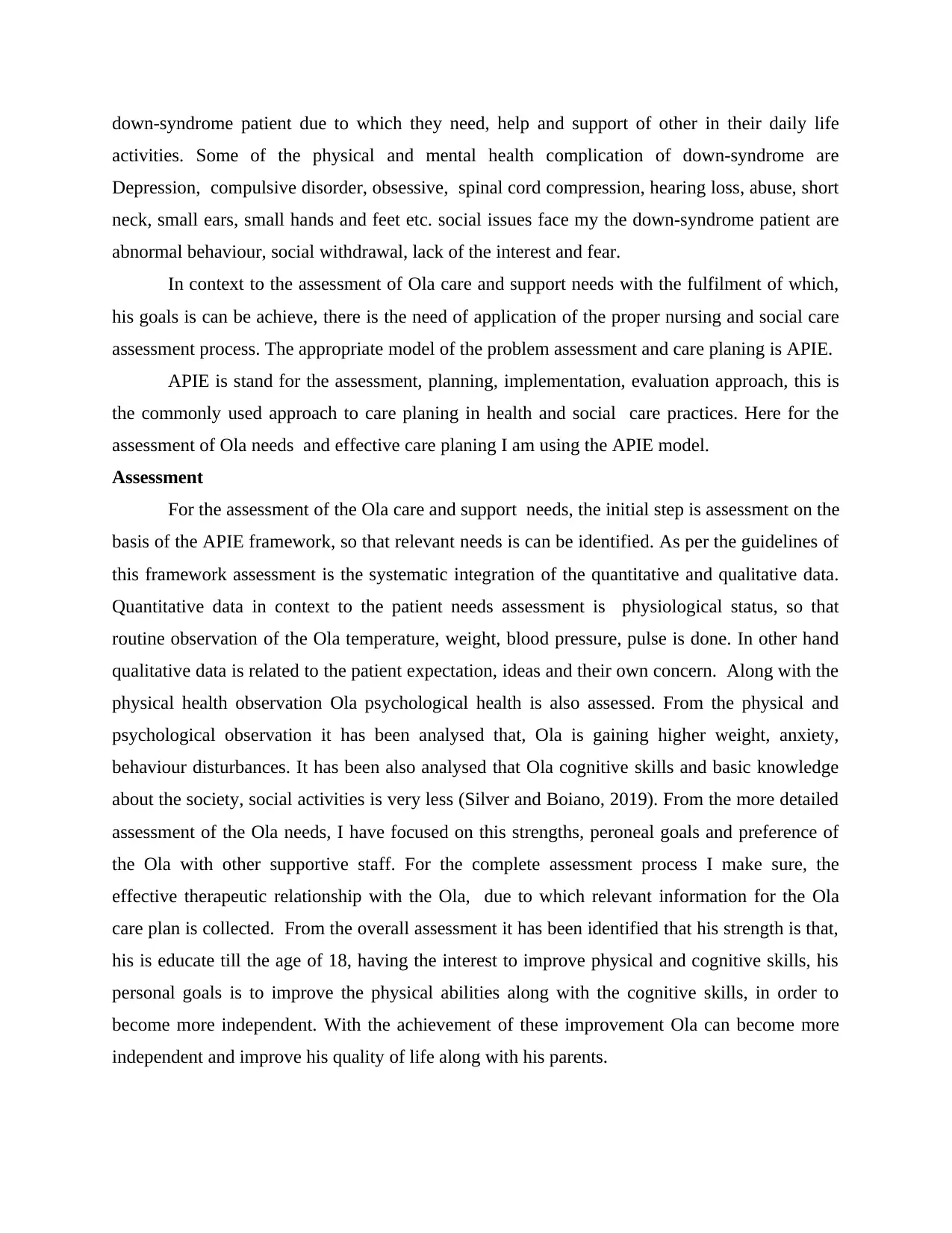
down-syndrome patient due to which they need, help and support of other in their daily life
activities. Some of the physical and mental health complication of down-syndrome are
Depression, compulsive disorder, obsessive, spinal cord compression, hearing loss, abuse, short
neck, small ears, small hands and feet etc. social issues face my the down-syndrome patient are
abnormal behaviour, social withdrawal, lack of the interest and fear.
In context to the assessment of Ola care and support needs with the fulfilment of which,
his goals is can be achieve, there is the need of application of the proper nursing and social care
assessment process. The appropriate model of the problem assessment and care planing is APIE.
APIE is stand for the assessment, planning, implementation, evaluation approach, this is
the commonly used approach to care planing in health and social care practices. Here for the
assessment of Ola needs and effective care planing I am using the APIE model.
Assessment
For the assessment of the Ola care and support needs, the initial step is assessment on the
basis of the APIE framework, so that relevant needs is can be identified. As per the guidelines of
this framework assessment is the systematic integration of the quantitative and qualitative data.
Quantitative data in context to the patient needs assessment is physiological status, so that
routine observation of the Ola temperature, weight, blood pressure, pulse is done. In other hand
qualitative data is related to the patient expectation, ideas and their own concern. Along with the
physical health observation Ola psychological health is also assessed. From the physical and
psychological observation it has been analysed that, Ola is gaining higher weight, anxiety,
behaviour disturbances. It has been also analysed that Ola cognitive skills and basic knowledge
about the society, social activities is very less (Silver and Boiano, 2019). From the more detailed
assessment of the Ola needs, I have focused on this strengths, peroneal goals and preference of
the Ola with other supportive staff. For the complete assessment process I make sure, the
effective therapeutic relationship with the Ola, due to which relevant information for the Ola
care plan is collected. From the overall assessment it has been identified that his strength is that,
his is educate till the age of 18, having the interest to improve physical and cognitive skills, his
personal goals is to improve the physical abilities along with the cognitive skills, in order to
become more independent. With the achievement of these improvement Ola can become more
independent and improve his quality of life along with his parents.
activities. Some of the physical and mental health complication of down-syndrome are
Depression, compulsive disorder, obsessive, spinal cord compression, hearing loss, abuse, short
neck, small ears, small hands and feet etc. social issues face my the down-syndrome patient are
abnormal behaviour, social withdrawal, lack of the interest and fear.
In context to the assessment of Ola care and support needs with the fulfilment of which,
his goals is can be achieve, there is the need of application of the proper nursing and social care
assessment process. The appropriate model of the problem assessment and care planing is APIE.
APIE is stand for the assessment, planning, implementation, evaluation approach, this is
the commonly used approach to care planing in health and social care practices. Here for the
assessment of Ola needs and effective care planing I am using the APIE model.
Assessment
For the assessment of the Ola care and support needs, the initial step is assessment on the
basis of the APIE framework, so that relevant needs is can be identified. As per the guidelines of
this framework assessment is the systematic integration of the quantitative and qualitative data.
Quantitative data in context to the patient needs assessment is physiological status, so that
routine observation of the Ola temperature, weight, blood pressure, pulse is done. In other hand
qualitative data is related to the patient expectation, ideas and their own concern. Along with the
physical health observation Ola psychological health is also assessed. From the physical and
psychological observation it has been analysed that, Ola is gaining higher weight, anxiety,
behaviour disturbances. It has been also analysed that Ola cognitive skills and basic knowledge
about the society, social activities is very less (Silver and Boiano, 2019). From the more detailed
assessment of the Ola needs, I have focused on this strengths, peroneal goals and preference of
the Ola with other supportive staff. For the complete assessment process I make sure, the
effective therapeutic relationship with the Ola, due to which relevant information for the Ola
care plan is collected. From the overall assessment it has been identified that his strength is that,
his is educate till the age of 18, having the interest to improve physical and cognitive skills, his
personal goals is to improve the physical abilities along with the cognitive skills, in order to
become more independent. With the achievement of these improvement Ola can become more
independent and improve his quality of life along with his parents.
Paraphrase This Document
Need a fresh take? Get an instant paraphrase of this document with our AI Paraphraser
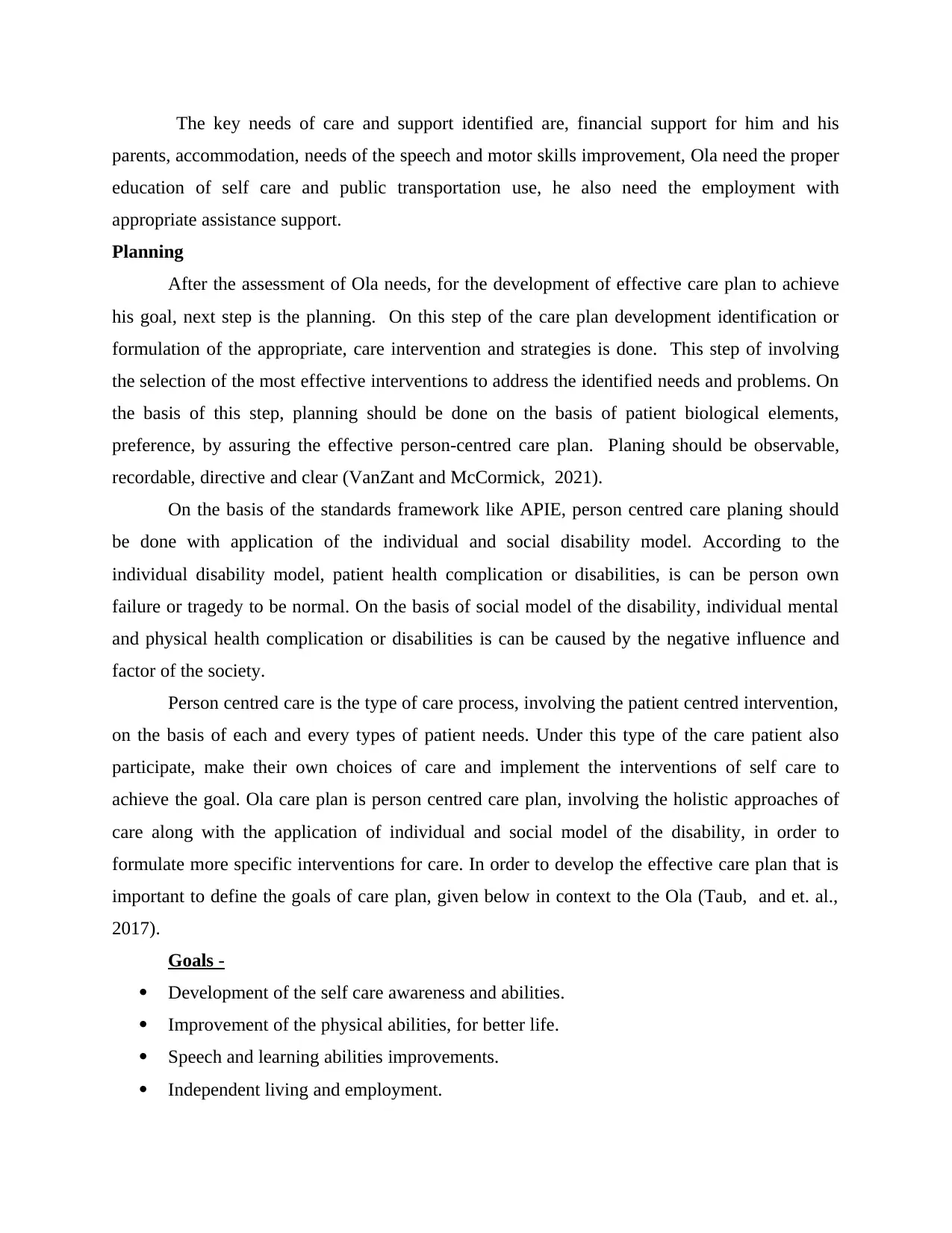
The key needs of care and support identified are, financial support for him and his
parents, accommodation, needs of the speech and motor skills improvement, Ola need the proper
education of self care and public transportation use, he also need the employment with
appropriate assistance support.
Planning
After the assessment of Ola needs, for the development of effective care plan to achieve
his goal, next step is the planning. On this step of the care plan development identification or
formulation of the appropriate, care intervention and strategies is done. This step of involving
the selection of the most effective interventions to address the identified needs and problems. On
the basis of this step, planning should be done on the basis of patient biological elements,
preference, by assuring the effective person-centred care plan. Planing should be observable,
recordable, directive and clear (VanZant and McCormick, 2021).
On the basis of the standards framework like APIE, person centred care planing should
be done with application of the individual and social disability model. According to the
individual disability model, patient health complication or disabilities, is can be person own
failure or tragedy to be normal. On the basis of social model of the disability, individual mental
and physical health complication or disabilities is can be caused by the negative influence and
factor of the society.
Person centred care is the type of care process, involving the patient centred intervention,
on the basis of each and every types of patient needs. Under this type of the care patient also
participate, make their own choices of care and implement the interventions of self care to
achieve the goal. Ola care plan is person centred care plan, involving the holistic approaches of
care along with the application of individual and social model of the disability, in order to
formulate more specific interventions for care. In order to develop the effective care plan that is
important to define the goals of care plan, given below in context to the Ola (Taub, and et. al.,
2017).
Goals -
Development of the self care awareness and abilities.
Improvement of the physical abilities, for better life.
Speech and learning abilities improvements.
Independent living and employment.
parents, accommodation, needs of the speech and motor skills improvement, Ola need the proper
education of self care and public transportation use, he also need the employment with
appropriate assistance support.
Planning
After the assessment of Ola needs, for the development of effective care plan to achieve
his goal, next step is the planning. On this step of the care plan development identification or
formulation of the appropriate, care intervention and strategies is done. This step of involving
the selection of the most effective interventions to address the identified needs and problems. On
the basis of this step, planning should be done on the basis of patient biological elements,
preference, by assuring the effective person-centred care plan. Planing should be observable,
recordable, directive and clear (VanZant and McCormick, 2021).
On the basis of the standards framework like APIE, person centred care planing should
be done with application of the individual and social disability model. According to the
individual disability model, patient health complication or disabilities, is can be person own
failure or tragedy to be normal. On the basis of social model of the disability, individual mental
and physical health complication or disabilities is can be caused by the negative influence and
factor of the society.
Person centred care is the type of care process, involving the patient centred intervention,
on the basis of each and every types of patient needs. Under this type of the care patient also
participate, make their own choices of care and implement the interventions of self care to
achieve the goal. Ola care plan is person centred care plan, involving the holistic approaches of
care along with the application of individual and social model of the disability, in order to
formulate more specific interventions for care. In order to develop the effective care plan that is
important to define the goals of care plan, given below in context to the Ola (Taub, and et. al.,
2017).
Goals -
Development of the self care awareness and abilities.
Improvement of the physical abilities, for better life.
Speech and learning abilities improvements.
Independent living and employment.
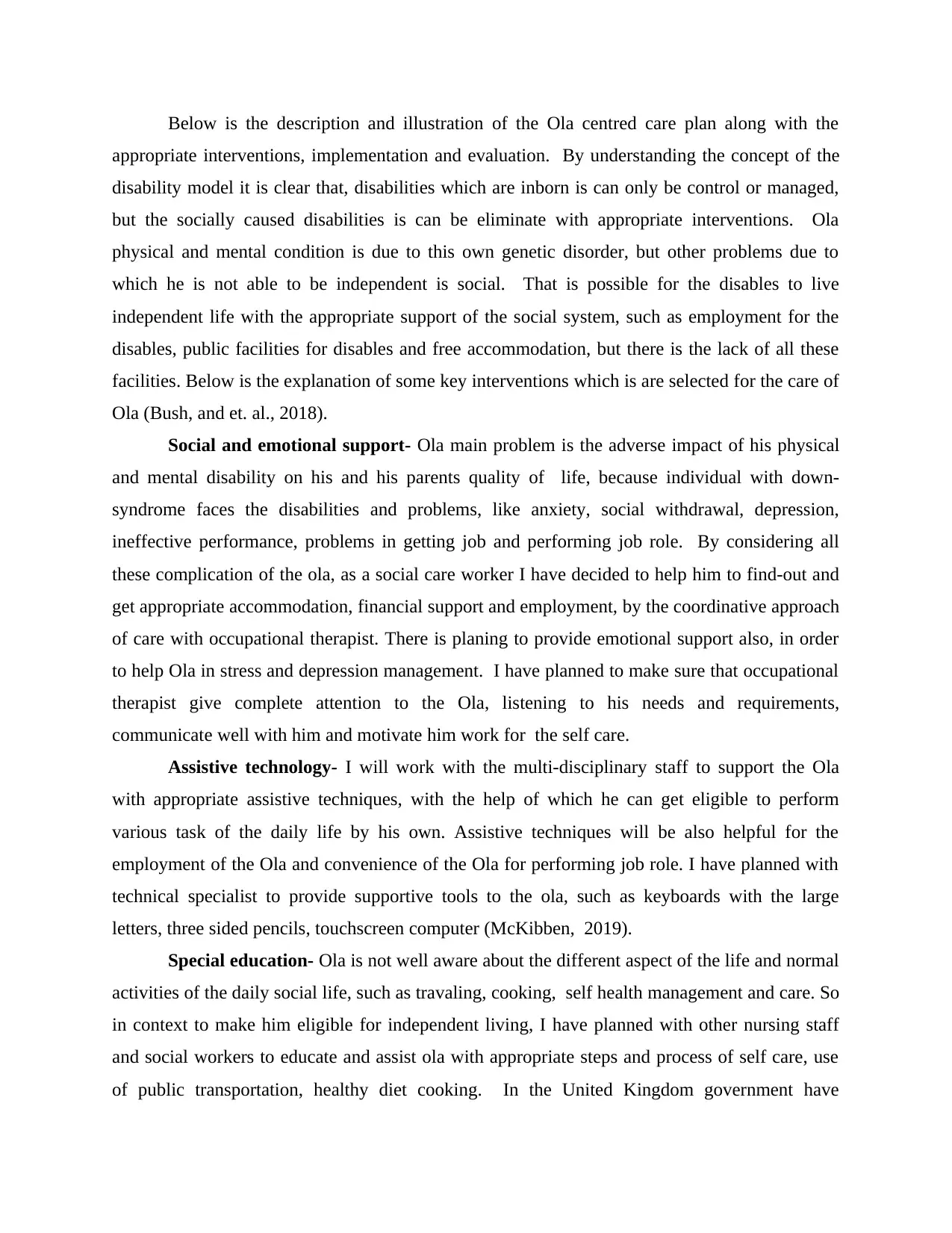
Below is the description and illustration of the Ola centred care plan along with the
appropriate interventions, implementation and evaluation. By understanding the concept of the
disability model it is clear that, disabilities which are inborn is can only be control or managed,
but the socially caused disabilities is can be eliminate with appropriate interventions. Ola
physical and mental condition is due to this own genetic disorder, but other problems due to
which he is not able to be independent is social. That is possible for the disables to live
independent life with the appropriate support of the social system, such as employment for the
disables, public facilities for disables and free accommodation, but there is the lack of all these
facilities. Below is the explanation of some key interventions which is are selected for the care of
Ola (Bush, and et. al., 2018).
Social and emotional support- Ola main problem is the adverse impact of his physical
and mental disability on his and his parents quality of life, because individual with down-
syndrome faces the disabilities and problems, like anxiety, social withdrawal, depression,
ineffective performance, problems in getting job and performing job role. By considering all
these complication of the ola, as a social care worker I have decided to help him to find-out and
get appropriate accommodation, financial support and employment, by the coordinative approach
of care with occupational therapist. There is planing to provide emotional support also, in order
to help Ola in stress and depression management. I have planned to make sure that occupational
therapist give complete attention to the Ola, listening to his needs and requirements,
communicate well with him and motivate him work for the self care.
Assistive technology- I will work with the multi-disciplinary staff to support the Ola
with appropriate assistive techniques, with the help of which he can get eligible to perform
various task of the daily life by his own. Assistive techniques will be also helpful for the
employment of the Ola and convenience of the Ola for performing job role. I have planned with
technical specialist to provide supportive tools to the ola, such as keyboards with the large
letters, three sided pencils, touchscreen computer (McKibben, 2019).
Special education- Ola is not well aware about the different aspect of the life and normal
activities of the daily social life, such as travaling, cooking, self health management and care. So
in context to make him eligible for independent living, I have planned with other nursing staff
and social workers to educate and assist ola with appropriate steps and process of self care, use
of public transportation, healthy diet cooking. In the United Kingdom government have
appropriate interventions, implementation and evaluation. By understanding the concept of the
disability model it is clear that, disabilities which are inborn is can only be control or managed,
but the socially caused disabilities is can be eliminate with appropriate interventions. Ola
physical and mental condition is due to this own genetic disorder, but other problems due to
which he is not able to be independent is social. That is possible for the disables to live
independent life with the appropriate support of the social system, such as employment for the
disables, public facilities for disables and free accommodation, but there is the lack of all these
facilities. Below is the explanation of some key interventions which is are selected for the care of
Ola (Bush, and et. al., 2018).
Social and emotional support- Ola main problem is the adverse impact of his physical
and mental disability on his and his parents quality of life, because individual with down-
syndrome faces the disabilities and problems, like anxiety, social withdrawal, depression,
ineffective performance, problems in getting job and performing job role. By considering all
these complication of the ola, as a social care worker I have decided to help him to find-out and
get appropriate accommodation, financial support and employment, by the coordinative approach
of care with occupational therapist. There is planing to provide emotional support also, in order
to help Ola in stress and depression management. I have planned to make sure that occupational
therapist give complete attention to the Ola, listening to his needs and requirements,
communicate well with him and motivate him work for the self care.
Assistive technology- I will work with the multi-disciplinary staff to support the Ola
with appropriate assistive techniques, with the help of which he can get eligible to perform
various task of the daily life by his own. Assistive techniques will be also helpful for the
employment of the Ola and convenience of the Ola for performing job role. I have planned with
technical specialist to provide supportive tools to the ola, such as keyboards with the large
letters, three sided pencils, touchscreen computer (McKibben, 2019).
Special education- Ola is not well aware about the different aspect of the life and normal
activities of the daily social life, such as travaling, cooking, self health management and care. So
in context to make him eligible for independent living, I have planned with other nursing staff
and social workers to educate and assist ola with appropriate steps and process of self care, use
of public transportation, healthy diet cooking. In the United Kingdom government have
⊘ This is a preview!⊘
Do you want full access?
Subscribe today to unlock all pages.

Trusted by 1+ million students worldwide
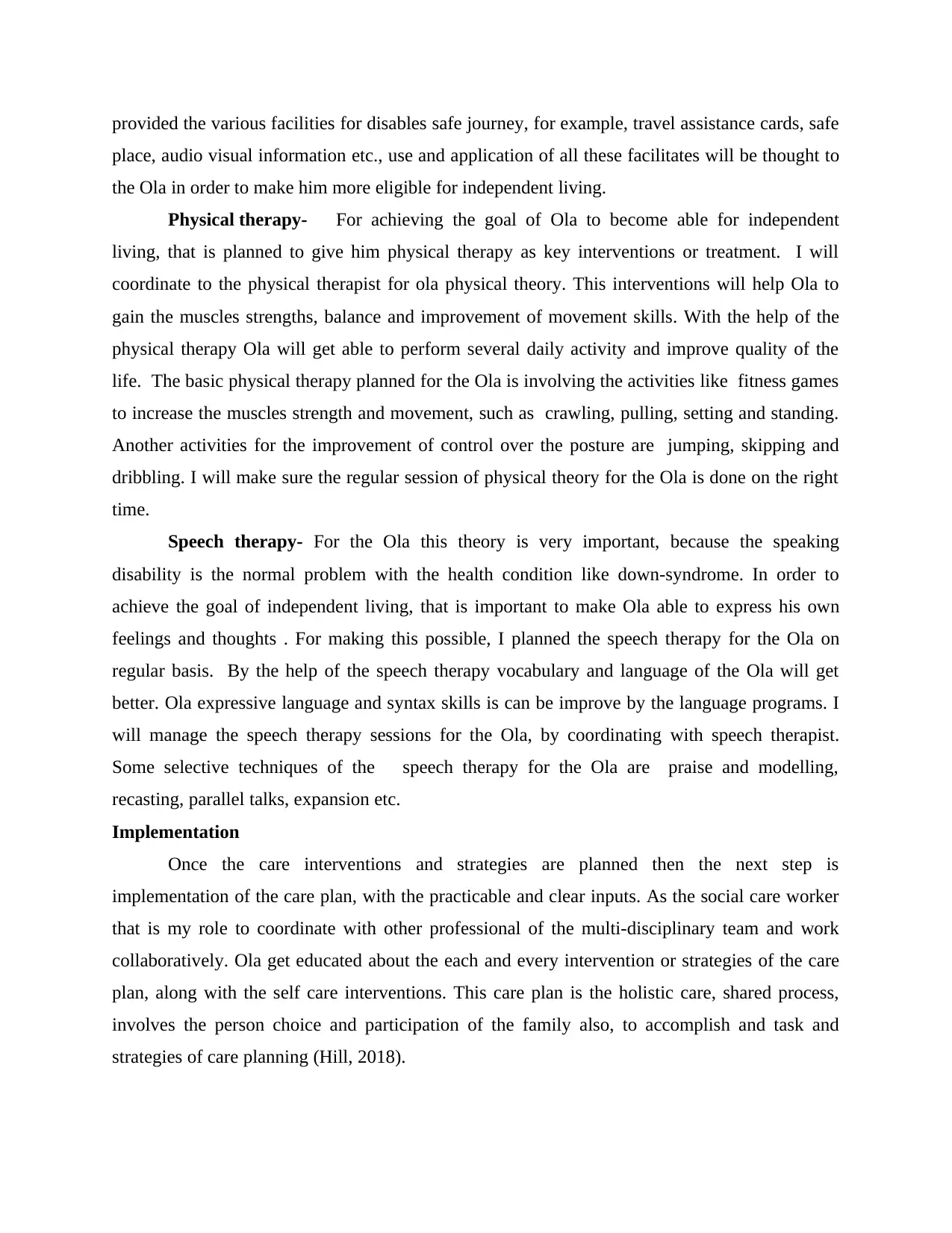
provided the various facilities for disables safe journey, for example, travel assistance cards, safe
place, audio visual information etc., use and application of all these facilitates will be thought to
the Ola in order to make him more eligible for independent living.
Physical therapy- For achieving the goal of Ola to become able for independent
living, that is planned to give him physical therapy as key interventions or treatment. I will
coordinate to the physical therapist for ola physical theory. This interventions will help Ola to
gain the muscles strengths, balance and improvement of movement skills. With the help of the
physical therapy Ola will get able to perform several daily activity and improve quality of the
life. The basic physical therapy planned for the Ola is involving the activities like fitness games
to increase the muscles strength and movement, such as crawling, pulling, setting and standing.
Another activities for the improvement of control over the posture are jumping, skipping and
dribbling. I will make sure the regular session of physical theory for the Ola is done on the right
time.
Speech therapy- For the Ola this theory is very important, because the speaking
disability is the normal problem with the health condition like down-syndrome. In order to
achieve the goal of independent living, that is important to make Ola able to express his own
feelings and thoughts . For making this possible, I planned the speech therapy for the Ola on
regular basis. By the help of the speech therapy vocabulary and language of the Ola will get
better. Ola expressive language and syntax skills is can be improve by the language programs. I
will manage the speech therapy sessions for the Ola, by coordinating with speech therapist.
Some selective techniques of the speech therapy for the Ola are praise and modelling,
recasting, parallel talks, expansion etc.
Implementation
Once the care interventions and strategies are planned then the next step is
implementation of the care plan, with the practicable and clear inputs. As the social care worker
that is my role to coordinate with other professional of the multi-disciplinary team and work
collaboratively. Ola get educated about the each and every intervention or strategies of the care
plan, along with the self care interventions. This care plan is the holistic care, shared process,
involves the person choice and participation of the family also, to accomplish and task and
strategies of care planning (Hill, 2018).
place, audio visual information etc., use and application of all these facilitates will be thought to
the Ola in order to make him more eligible for independent living.
Physical therapy- For achieving the goal of Ola to become able for independent
living, that is planned to give him physical therapy as key interventions or treatment. I will
coordinate to the physical therapist for ola physical theory. This interventions will help Ola to
gain the muscles strengths, balance and improvement of movement skills. With the help of the
physical therapy Ola will get able to perform several daily activity and improve quality of the
life. The basic physical therapy planned for the Ola is involving the activities like fitness games
to increase the muscles strength and movement, such as crawling, pulling, setting and standing.
Another activities for the improvement of control over the posture are jumping, skipping and
dribbling. I will make sure the regular session of physical theory for the Ola is done on the right
time.
Speech therapy- For the Ola this theory is very important, because the speaking
disability is the normal problem with the health condition like down-syndrome. In order to
achieve the goal of independent living, that is important to make Ola able to express his own
feelings and thoughts . For making this possible, I planned the speech therapy for the Ola on
regular basis. By the help of the speech therapy vocabulary and language of the Ola will get
better. Ola expressive language and syntax skills is can be improve by the language programs. I
will manage the speech therapy sessions for the Ola, by coordinating with speech therapist.
Some selective techniques of the speech therapy for the Ola are praise and modelling,
recasting, parallel talks, expansion etc.
Implementation
Once the care interventions and strategies are planned then the next step is
implementation of the care plan, with the practicable and clear inputs. As the social care worker
that is my role to coordinate with other professional of the multi-disciplinary team and work
collaboratively. Ola get educated about the each and every intervention or strategies of the care
plan, along with the self care interventions. This care plan is the holistic care, shared process,
involves the person choice and participation of the family also, to accomplish and task and
strategies of care planning (Hill, 2018).
Paraphrase This Document
Need a fresh take? Get an instant paraphrase of this document with our AI Paraphraser
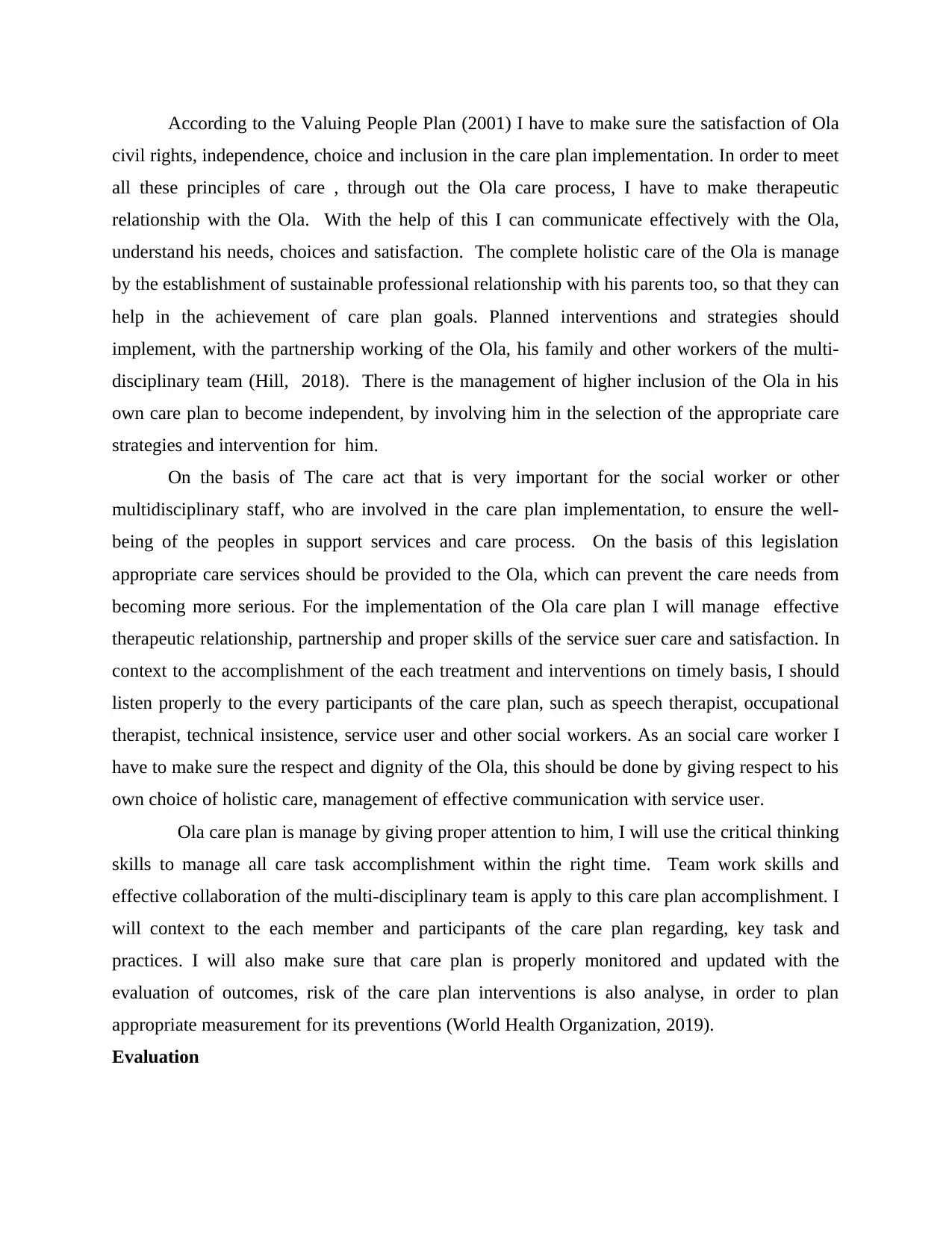
According to the Valuing People Plan (2001) I have to make sure the satisfaction of Ola
civil rights, independence, choice and inclusion in the care plan implementation. In order to meet
all these principles of care , through out the Ola care process, I have to make therapeutic
relationship with the Ola. With the help of this I can communicate effectively with the Ola,
understand his needs, choices and satisfaction. The complete holistic care of the Ola is manage
by the establishment of sustainable professional relationship with his parents too, so that they can
help in the achievement of care plan goals. Planned interventions and strategies should
implement, with the partnership working of the Ola, his family and other workers of the multi-
disciplinary team (Hill, 2018). There is the management of higher inclusion of the Ola in his
own care plan to become independent, by involving him in the selection of the appropriate care
strategies and intervention for him.
On the basis of The care act that is very important for the social worker or other
multidisciplinary staff, who are involved in the care plan implementation, to ensure the well-
being of the peoples in support services and care process. On the basis of this legislation
appropriate care services should be provided to the Ola, which can prevent the care needs from
becoming more serious. For the implementation of the Ola care plan I will manage effective
therapeutic relationship, partnership and proper skills of the service suer care and satisfaction. In
context to the accomplishment of the each treatment and interventions on timely basis, I should
listen properly to the every participants of the care plan, such as speech therapist, occupational
therapist, technical insistence, service user and other social workers. As an social care worker I
have to make sure the respect and dignity of the Ola, this should be done by giving respect to his
own choice of holistic care, management of effective communication with service user.
Ola care plan is manage by giving proper attention to him, I will use the critical thinking
skills to manage all care task accomplishment within the right time. Team work skills and
effective collaboration of the multi-disciplinary team is apply to this care plan accomplishment. I
will context to the each member and participants of the care plan regarding, key task and
practices. I will also make sure that care plan is properly monitored and updated with the
evaluation of outcomes, risk of the care plan interventions is also analyse, in order to plan
appropriate measurement for its preventions (World Health Organization, 2019).
Evaluation
civil rights, independence, choice and inclusion in the care plan implementation. In order to meet
all these principles of care , through out the Ola care process, I have to make therapeutic
relationship with the Ola. With the help of this I can communicate effectively with the Ola,
understand his needs, choices and satisfaction. The complete holistic care of the Ola is manage
by the establishment of sustainable professional relationship with his parents too, so that they can
help in the achievement of care plan goals. Planned interventions and strategies should
implement, with the partnership working of the Ola, his family and other workers of the multi-
disciplinary team (Hill, 2018). There is the management of higher inclusion of the Ola in his
own care plan to become independent, by involving him in the selection of the appropriate care
strategies and intervention for him.
On the basis of The care act that is very important for the social worker or other
multidisciplinary staff, who are involved in the care plan implementation, to ensure the well-
being of the peoples in support services and care process. On the basis of this legislation
appropriate care services should be provided to the Ola, which can prevent the care needs from
becoming more serious. For the implementation of the Ola care plan I will manage effective
therapeutic relationship, partnership and proper skills of the service suer care and satisfaction. In
context to the accomplishment of the each treatment and interventions on timely basis, I should
listen properly to the every participants of the care plan, such as speech therapist, occupational
therapist, technical insistence, service user and other social workers. As an social care worker I
have to make sure the respect and dignity of the Ola, this should be done by giving respect to his
own choice of holistic care, management of effective communication with service user.
Ola care plan is manage by giving proper attention to him, I will use the critical thinking
skills to manage all care task accomplishment within the right time. Team work skills and
effective collaboration of the multi-disciplinary team is apply to this care plan accomplishment. I
will context to the each member and participants of the care plan regarding, key task and
practices. I will also make sure that care plan is properly monitored and updated with the
evaluation of outcomes, risk of the care plan interventions is also analyse, in order to plan
appropriate measurement for its preventions (World Health Organization, 2019).
Evaluation
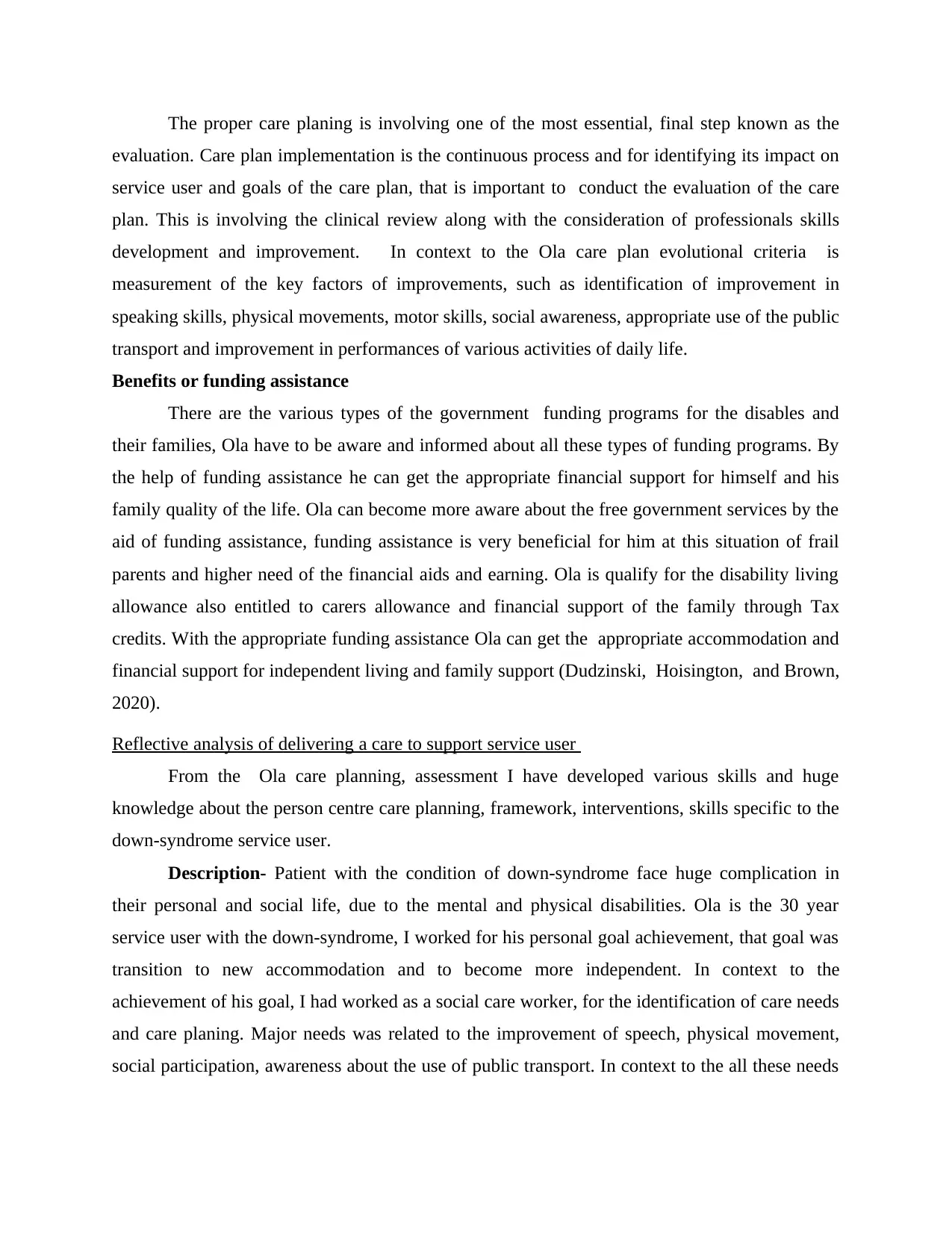
The proper care planing is involving one of the most essential, final step known as the
evaluation. Care plan implementation is the continuous process and for identifying its impact on
service user and goals of the care plan, that is important to conduct the evaluation of the care
plan. This is involving the clinical review along with the consideration of professionals skills
development and improvement. In context to the Ola care plan evolutional criteria is
measurement of the key factors of improvements, such as identification of improvement in
speaking skills, physical movements, motor skills, social awareness, appropriate use of the public
transport and improvement in performances of various activities of daily life.
Benefits or funding assistance
There are the various types of the government funding programs for the disables and
their families, Ola have to be aware and informed about all these types of funding programs. By
the help of funding assistance he can get the appropriate financial support for himself and his
family quality of the life. Ola can become more aware about the free government services by the
aid of funding assistance, funding assistance is very beneficial for him at this situation of frail
parents and higher need of the financial aids and earning. Ola is qualify for the disability living
allowance also entitled to carers allowance and financial support of the family through Tax
credits. With the appropriate funding assistance Ola can get the appropriate accommodation and
financial support for independent living and family support (Dudzinski, Hoisington, and Brown,
2020).
Reflective analysis of delivering a care to support service user
From the Ola care planning, assessment I have developed various skills and huge
knowledge about the person centre care planning, framework, interventions, skills specific to the
down-syndrome service user.
Description- Patient with the condition of down-syndrome face huge complication in
their personal and social life, due to the mental and physical disabilities. Ola is the 30 year
service user with the down-syndrome, I worked for his personal goal achievement, that goal was
transition to new accommodation and to become more independent. In context to the
achievement of his goal, I had worked as a social care worker, for the identification of care needs
and care planing. Major needs was related to the improvement of speech, physical movement,
social participation, awareness about the use of public transport. In context to the all these needs
evaluation. Care plan implementation is the continuous process and for identifying its impact on
service user and goals of the care plan, that is important to conduct the evaluation of the care
plan. This is involving the clinical review along with the consideration of professionals skills
development and improvement. In context to the Ola care plan evolutional criteria is
measurement of the key factors of improvements, such as identification of improvement in
speaking skills, physical movements, motor skills, social awareness, appropriate use of the public
transport and improvement in performances of various activities of daily life.
Benefits or funding assistance
There are the various types of the government funding programs for the disables and
their families, Ola have to be aware and informed about all these types of funding programs. By
the help of funding assistance he can get the appropriate financial support for himself and his
family quality of the life. Ola can become more aware about the free government services by the
aid of funding assistance, funding assistance is very beneficial for him at this situation of frail
parents and higher need of the financial aids and earning. Ola is qualify for the disability living
allowance also entitled to carers allowance and financial support of the family through Tax
credits. With the appropriate funding assistance Ola can get the appropriate accommodation and
financial support for independent living and family support (Dudzinski, Hoisington, and Brown,
2020).
Reflective analysis of delivering a care to support service user
From the Ola care planning, assessment I have developed various skills and huge
knowledge about the person centre care planning, framework, interventions, skills specific to the
down-syndrome service user.
Description- Patient with the condition of down-syndrome face huge complication in
their personal and social life, due to the mental and physical disabilities. Ola is the 30 year
service user with the down-syndrome, I worked for his personal goal achievement, that goal was
transition to new accommodation and to become more independent. In context to the
achievement of his goal, I had worked as a social care worker, for the identification of care needs
and care planing. Major needs was related to the improvement of speech, physical movement,
social participation, awareness about the use of public transport. In context to the all these needs
⊘ This is a preview!⊘
Do you want full access?
Subscribe today to unlock all pages.

Trusted by 1+ million students worldwide
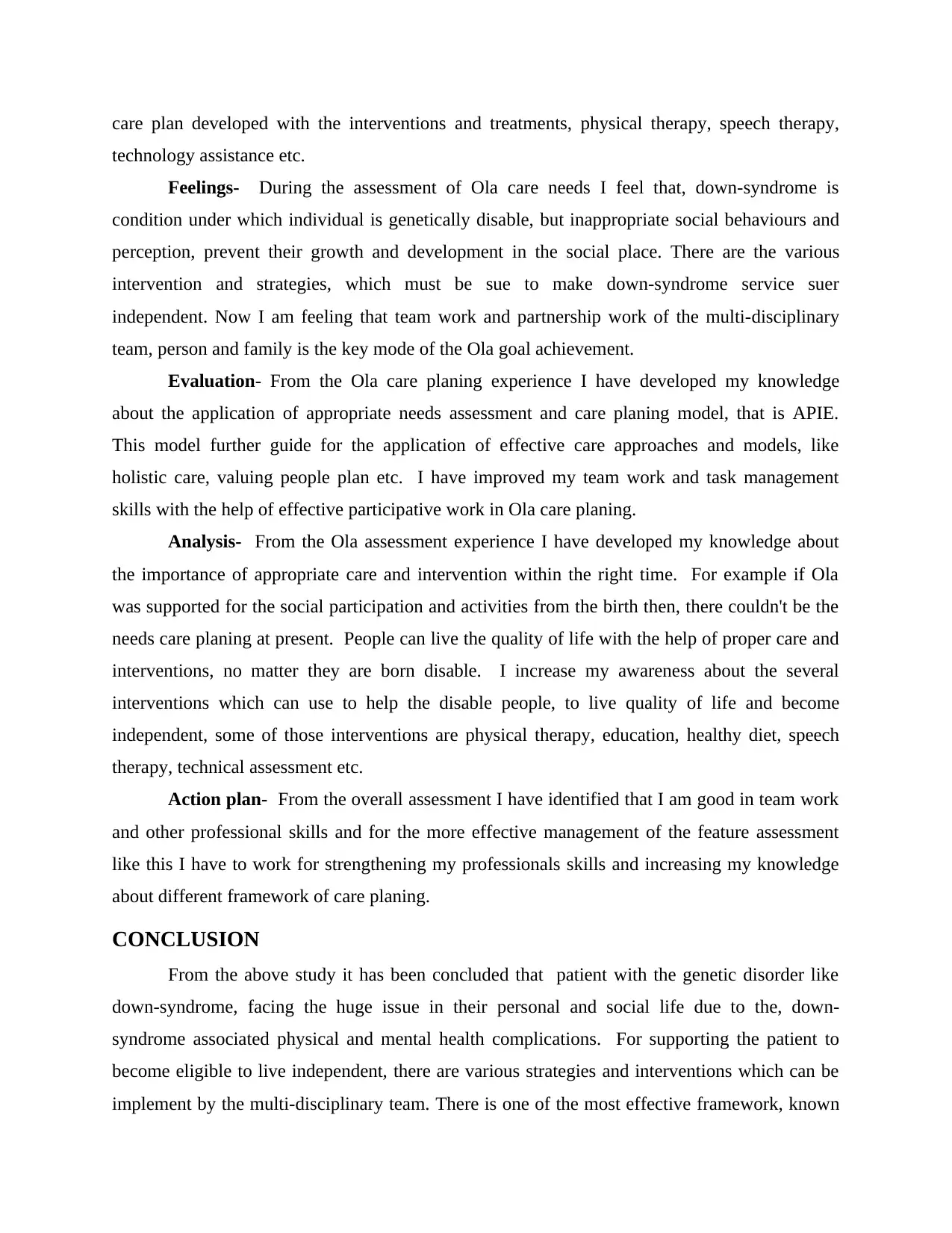
care plan developed with the interventions and treatments, physical therapy, speech therapy,
technology assistance etc.
Feelings- During the assessment of Ola care needs I feel that, down-syndrome is
condition under which individual is genetically disable, but inappropriate social behaviours and
perception, prevent their growth and development in the social place. There are the various
intervention and strategies, which must be sue to make down-syndrome service suer
independent. Now I am feeling that team work and partnership work of the multi-disciplinary
team, person and family is the key mode of the Ola goal achievement.
Evaluation- From the Ola care planing experience I have developed my knowledge
about the application of appropriate needs assessment and care planing model, that is APIE.
This model further guide for the application of effective care approaches and models, like
holistic care, valuing people plan etc. I have improved my team work and task management
skills with the help of effective participative work in Ola care planing.
Analysis- From the Ola assessment experience I have developed my knowledge about
the importance of appropriate care and intervention within the right time. For example if Ola
was supported for the social participation and activities from the birth then, there couldn't be the
needs care planing at present. People can live the quality of life with the help of proper care and
interventions, no matter they are born disable. I increase my awareness about the several
interventions which can use to help the disable people, to live quality of life and become
independent, some of those interventions are physical therapy, education, healthy diet, speech
therapy, technical assessment etc.
Action plan- From the overall assessment I have identified that I am good in team work
and other professional skills and for the more effective management of the feature assessment
like this I have to work for strengthening my professionals skills and increasing my knowledge
about different framework of care planing.
CONCLUSION
From the above study it has been concluded that patient with the genetic disorder like
down-syndrome, facing the huge issue in their personal and social life due to the, down-
syndrome associated physical and mental health complications. For supporting the patient to
become eligible to live independent, there are various strategies and interventions which can be
implement by the multi-disciplinary team. There is one of the most effective framework, known
technology assistance etc.
Feelings- During the assessment of Ola care needs I feel that, down-syndrome is
condition under which individual is genetically disable, but inappropriate social behaviours and
perception, prevent their growth and development in the social place. There are the various
intervention and strategies, which must be sue to make down-syndrome service suer
independent. Now I am feeling that team work and partnership work of the multi-disciplinary
team, person and family is the key mode of the Ola goal achievement.
Evaluation- From the Ola care planing experience I have developed my knowledge
about the application of appropriate needs assessment and care planing model, that is APIE.
This model further guide for the application of effective care approaches and models, like
holistic care, valuing people plan etc. I have improved my team work and task management
skills with the help of effective participative work in Ola care planing.
Analysis- From the Ola assessment experience I have developed my knowledge about
the importance of appropriate care and intervention within the right time. For example if Ola
was supported for the social participation and activities from the birth then, there couldn't be the
needs care planing at present. People can live the quality of life with the help of proper care and
interventions, no matter they are born disable. I increase my awareness about the several
interventions which can use to help the disable people, to live quality of life and become
independent, some of those interventions are physical therapy, education, healthy diet, speech
therapy, technical assessment etc.
Action plan- From the overall assessment I have identified that I am good in team work
and other professional skills and for the more effective management of the feature assessment
like this I have to work for strengthening my professionals skills and increasing my knowledge
about different framework of care planing.
CONCLUSION
From the above study it has been concluded that patient with the genetic disorder like
down-syndrome, facing the huge issue in their personal and social life due to the, down-
syndrome associated physical and mental health complications. For supporting the patient to
become eligible to live independent, there are various strategies and interventions which can be
implement by the multi-disciplinary team. There is one of the most effective framework, known
Paraphrase This Document
Need a fresh take? Get an instant paraphrase of this document with our AI Paraphraser
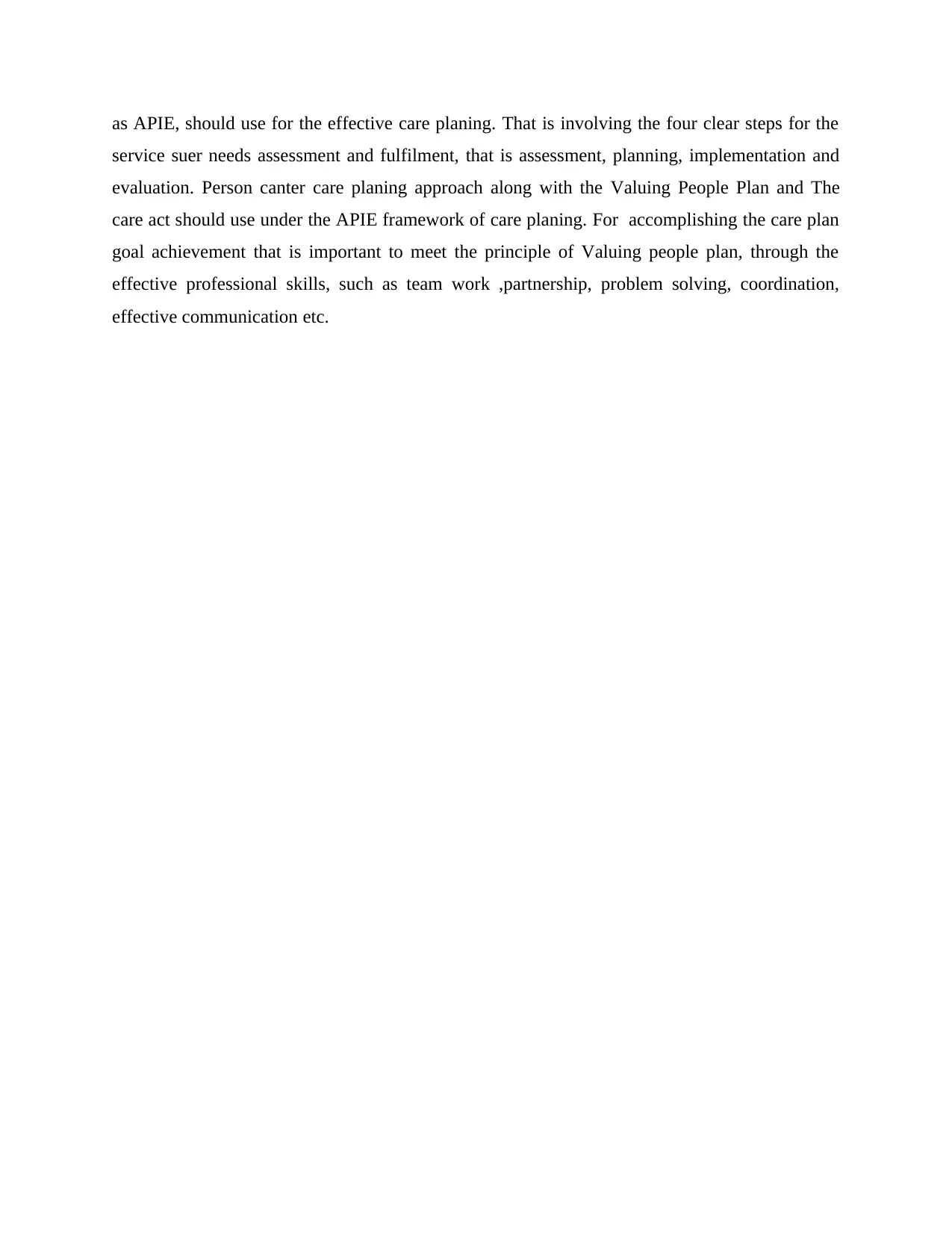
as APIE, should use for the effective care planing. That is involving the four clear steps for the
service suer needs assessment and fulfilment, that is assessment, planning, implementation and
evaluation. Person canter care planing approach along with the Valuing People Plan and The
care act should use under the APIE framework of care planing. For accomplishing the care plan
goal achievement that is important to meet the principle of Valuing people plan, through the
effective professional skills, such as team work ,partnership, problem solving, coordination,
effective communication etc.
service suer needs assessment and fulfilment, that is assessment, planning, implementation and
evaluation. Person canter care planing approach along with the Valuing People Plan and The
care act should use under the APIE framework of care planing. For accomplishing the care plan
goal achievement that is important to meet the principle of Valuing people plan, through the
effective professional skills, such as team work ,partnership, problem solving, coordination,
effective communication etc.
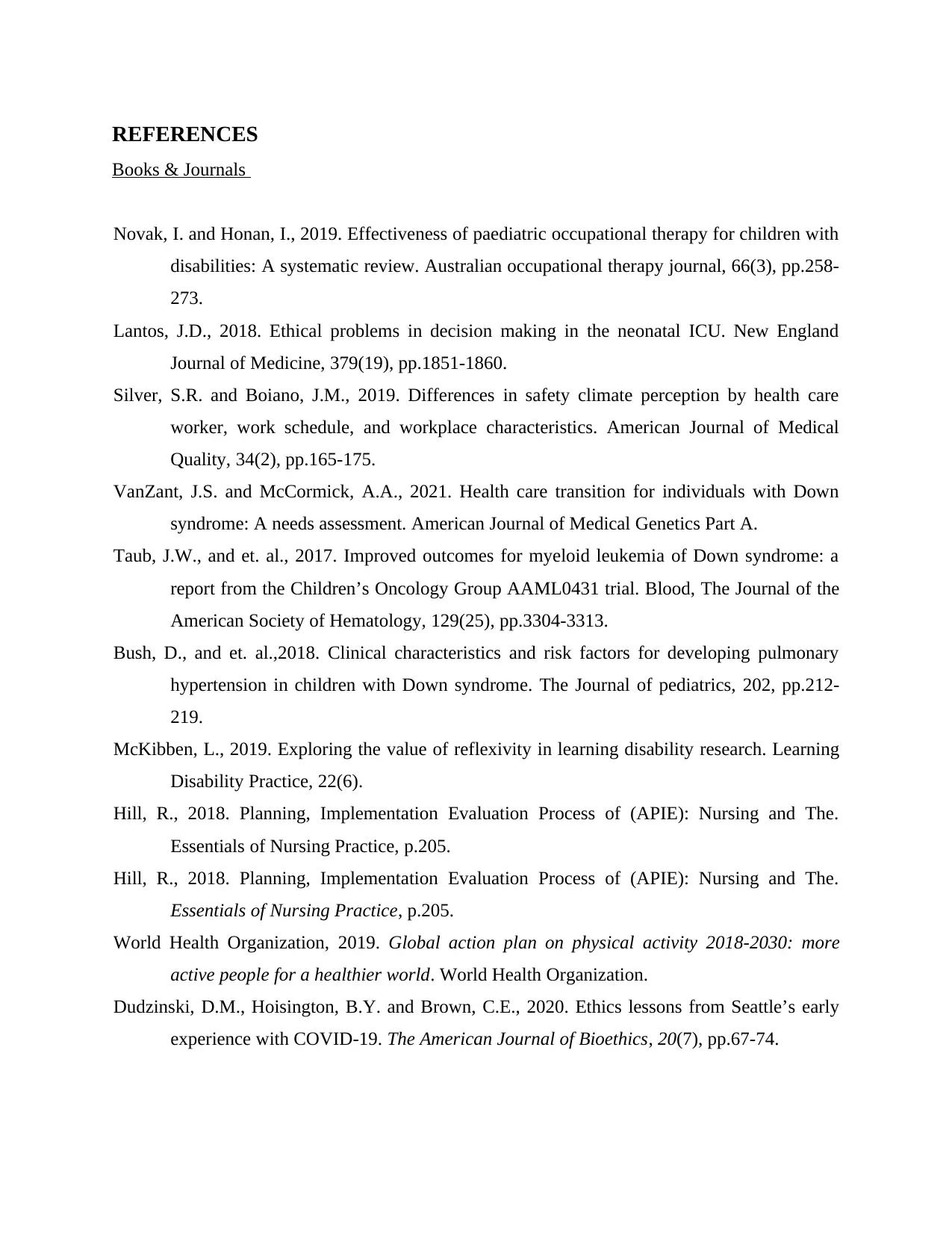
REFERENCES
Books & Journals
Novak, I. and Honan, I., 2019. Effectiveness of paediatric occupational therapy for children with
disabilities: A systematic review. Australian occupational therapy journal, 66(3), pp.258-
273.
Lantos, J.D., 2018. Ethical problems in decision making in the neonatal ICU. New England
Journal of Medicine, 379(19), pp.1851-1860.
Silver, S.R. and Boiano, J.M., 2019. Differences in safety climate perception by health care
worker, work schedule, and workplace characteristics. American Journal of Medical
Quality, 34(2), pp.165-175.
VanZant, J.S. and McCormick, A.A., 2021. Health care transition for individuals with Down
syndrome: A needs assessment. American Journal of Medical Genetics Part A.
Taub, J.W., and et. al., 2017. Improved outcomes for myeloid leukemia of Down syndrome: a
report from the Children’s Oncology Group AAML0431 trial. Blood, The Journal of the
American Society of Hematology, 129(25), pp.3304-3313.
Bush, D., and et. al.,2018. Clinical characteristics and risk factors for developing pulmonary
hypertension in children with Down syndrome. The Journal of pediatrics, 202, pp.212-
219.
McKibben, L., 2019. Exploring the value of reflexivity in learning disability research. Learning
Disability Practice, 22(6).
Hill, R., 2018. Planning, Implementation Evaluation Process of (APIE): Nursing and The.
Essentials of Nursing Practice, p.205.
Hill, R., 2018. Planning, Implementation Evaluation Process of (APIE): Nursing and The.
Essentials of Nursing Practice, p.205.
World Health Organization, 2019. Global action plan on physical activity 2018-2030: more
active people for a healthier world. World Health Organization.
Dudzinski, D.M., Hoisington, B.Y. and Brown, C.E., 2020. Ethics lessons from Seattle’s early
experience with COVID-19. The American Journal of Bioethics, 20(7), pp.67-74.
Books & Journals
Novak, I. and Honan, I., 2019. Effectiveness of paediatric occupational therapy for children with
disabilities: A systematic review. Australian occupational therapy journal, 66(3), pp.258-
273.
Lantos, J.D., 2018. Ethical problems in decision making in the neonatal ICU. New England
Journal of Medicine, 379(19), pp.1851-1860.
Silver, S.R. and Boiano, J.M., 2019. Differences in safety climate perception by health care
worker, work schedule, and workplace characteristics. American Journal of Medical
Quality, 34(2), pp.165-175.
VanZant, J.S. and McCormick, A.A., 2021. Health care transition for individuals with Down
syndrome: A needs assessment. American Journal of Medical Genetics Part A.
Taub, J.W., and et. al., 2017. Improved outcomes for myeloid leukemia of Down syndrome: a
report from the Children’s Oncology Group AAML0431 trial. Blood, The Journal of the
American Society of Hematology, 129(25), pp.3304-3313.
Bush, D., and et. al.,2018. Clinical characteristics and risk factors for developing pulmonary
hypertension in children with Down syndrome. The Journal of pediatrics, 202, pp.212-
219.
McKibben, L., 2019. Exploring the value of reflexivity in learning disability research. Learning
Disability Practice, 22(6).
Hill, R., 2018. Planning, Implementation Evaluation Process of (APIE): Nursing and The.
Essentials of Nursing Practice, p.205.
Hill, R., 2018. Planning, Implementation Evaluation Process of (APIE): Nursing and The.
Essentials of Nursing Practice, p.205.
World Health Organization, 2019. Global action plan on physical activity 2018-2030: more
active people for a healthier world. World Health Organization.
Dudzinski, D.M., Hoisington, B.Y. and Brown, C.E., 2020. Ethics lessons from Seattle’s early
experience with COVID-19. The American Journal of Bioethics, 20(7), pp.67-74.
⊘ This is a preview!⊘
Do you want full access?
Subscribe today to unlock all pages.

Trusted by 1+ million students worldwide
1 out of 15
Related Documents
Your All-in-One AI-Powered Toolkit for Academic Success.
+13062052269
info@desklib.com
Available 24*7 on WhatsApp / Email
![[object Object]](/_next/static/media/star-bottom.7253800d.svg)
Unlock your academic potential
Copyright © 2020–2025 A2Z Services. All Rights Reserved. Developed and managed by ZUCOL.
